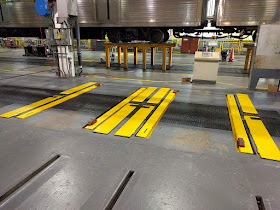To get to the Metro Subway Shoppes, we took mass transit. However the Metro and Light Rail lines do not have a direct connection. The best that is offered are two block long walking connections at Cultural Center / State Center and Lexington Market. Here we see Maryland LINK painted LRV #5019 dropping off tour participants at the Cultural Center station.
The Reisterstown Plaza station offers a sweeping curve west of the platform where one can get entire trainsets in the frame. A similar vantage is offered for eastbound trains at Millford Mill. The Metro runs with 4 or 6 car consists.
Here we see a diagram of the yard on the Yardmaster's console. The yard is a typical storage facility and shoppe combination, however there is a stub tail track at each end with access being provided via a number of main line connections on the north side. Long story short, you aren't getting out of the yard without at least one backup move.
We begin with the replacement truck storage area, which is currently sitting empty because truck rebuilding has been outsourced and most of the spare trucks were currently off property. The area is also equipped with a pair of lifts so that workers can get more easily to under-frame elements.
Spare motors, however, were on hand. They are of the DC variety in the 120hp range. Like the trucks, overhaul of the motors has also been outsourced to the same outfit that rebuild's WMATA's motors.
One thing the Metro Subway shoppe still rebuilds in house are the thyristor chopper motor controllers. By chopping a DC current, the apparent voltage is reduced and fine grain speed control is achievable with a solid state device. Much more efficient than cam controlled resistance drives, however still note the large heat sinks.
Heavy machinery abounds like this turret lathe.
Ground level spare DC motors (info) with the inspection plates removed to show the commutators. What's not to like about a motor system that is easily repairable with domestically sourced components!
The UTV's used a new inboard bearing truck design that was distinct from either the Poineer III or GSI 70 trucks that dominated the market at the time. I wonder if this design ever went on to see non-Budd use?
Couplers were of the Tomlinson or "hook" type. Here we can see the back stage bits for the coupler as well as the drawbar.
Over-running third rail shoe assembly. The shoppe foreman said that every employee there had been "bitten" by the 750v at some point or another, despite taking all the usual precautions.
The Budd new design trucks use hollow axles to save weight. Counterintuitively a hollow axle is just as strong as a solid axle thanks to physics. BTW, shouldn't there be more wheel chalks on the jackstand? 😱
Auxiliary control box that has fuses and other controls for all of the auxiliary items on the train such as lights and HVAC.
Wasn't sure what this large coil was for. Possibly some sort of current smoothing.
Baltimore Metro UTV #152 standing above the wide inspection pit. These vehicles are reaching the end of their lives and a contract has already been signed with Breda for a new fleet. Like the original fleet, the Miami Metrorail is purchasing similar cars so the two systems will retain parts commonality.
Baltimore Chapter tour group walking down one of the empty shoppe tracks. Equipment used for truck replacement can be seen in the foreground. The fleet was refreshed once about 10 years ago with new LED signs and automated anouncements, but not much else. A complete rebuild was considered, but ultimately Breda made a combined vehicle and signaling system offer that was arguably a better value. Miami is getting its new cars first and therefore more spare parts are becoming available to keep the Baltimore UTV fleet running until 2022 or so.
Here we see a single married pair sitting out in the east yard. Baltimore purchased 100 of these vehicles to equip what would be a multi-line heavy rail system on par with Toronto. However only the initial line was completed with a 2 station expansion to Johns Hopkins Hospital in the 1990's. As a result only between 54 and 66 cars are needed for a typical rush hour service and at the time of the tour only 72 of the 100 cars were fit for operation as excess cars were run down or cannibalized in anticipation of the fleet replacement. As there are no more active plans to expand the Metro Subway, only 78 new cars will replace the 100 Budds.
Thanks to the fine work by Budd, Baltimore's UTV's still look great and although it was a bit cluttered, the shoppe was in good nick as well.
Empty inspecting track looking westward.
Every shoppe has a wheel mill and the Metro Subway shoppe was no exception. This one seemed to be a bit less of a beast than the Light Rail shoppe's.
After the tour completed we headed back to the Reisterstown Plaza station where participants would be taken back to their vehicles at the North Ave shoppes. Here we see a westbound Metro Subway train pulling into the station via the ramp structure that allows yard access movements to avoid conflicting with main line traffic.
Eastbound train arriving at the other end of the station.
Back at Cultural Centre, Frutopia wrapped LRV #5015 was headed southbound.
At this point I proceeded to head home on my own. I just want to give another thank you to the Baltimore Chapter NRHS for letting me tag along. Hopefully there will be more such events in the future.




























No comments:
Post a Comment